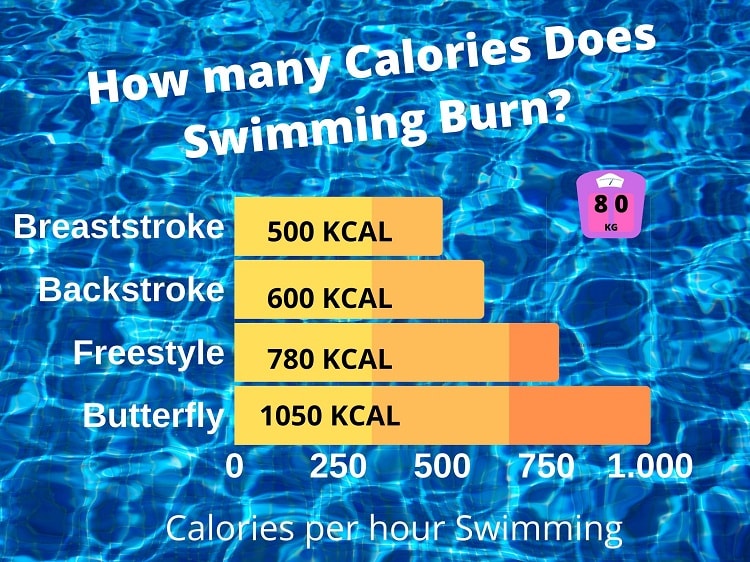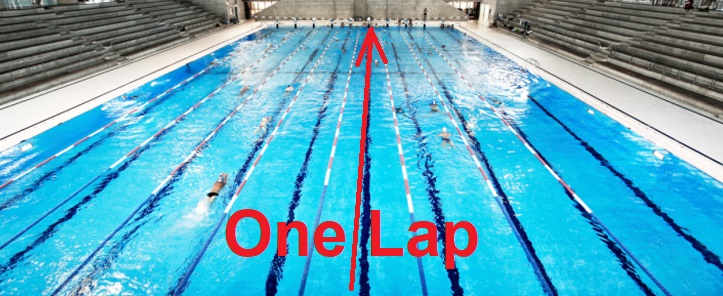How many calories do you burn swimming?
There’s no beating swimming if you’re looking for a healthy and effective way to easily burn plenty of calories. And it’s relatively easy for most of us to get started with the sport. Nearly everyone learns to swim as a child and there’s usually a swimmingpool not too far away with dedicated sessions for swimming laps. If the weather’s decent and the water is not too cold, you may even be able to take a dip in a lake or the sea. In fact, all you really need is a swimsuit or shorts!

Breaststroke, front crawl or backstroke? Which is better?
How many calories you burn when swimming has a lot to do with which
stroke you use. Calculate how many calories you burn with each different
stroke: Breast stroke, Backstroke, Freestyle or Butterfly.

| 140 lbs | 160 lbs | 180 lbs | 200 lbs | |
|---|---|---|---|---|
| Swimming | 320 kcal | 366 kcal | 411 kcal | 457 kcal |
| Swimming - Backstroke | 373 kcal | 427 kcal | 480 kcal | 533 kcal |
| Swimming - Breaststroke | 320 kcal | 366 kcal | 411 kcal | 457 kcal |
| Swimming Freestyle | 493 kcal | 564 kcal | 634 kcal | 705 kcal |
| Swimming - Butterfly stroke | 733 kcal | 838 kcal | 943 kcal | 1048 kcal |
| Swimming - Front Crawl | 493 kcal | 564 kcal | 634 kcal | 705 kcal |
Is swimming a good way to lose weight?
If you want to lose weight, it’s important to combine a healthy diet with regular exercise. And swimming is the ideal sport for shedding some pounds! This is because it’s an endurance sport, which means you mostly burn fat. With more explosive activities such as martial arts, gym workouts and hockey, your body mostly burns carbs.
Swimming exerts minimal pressure on your muscles, as the water carries most of your weight. That means it’s a great sport for those who are prone to injuries or are overweight (calculate your BMI).
You use nearly every muscle in your body while swimming and because your entire body is moving, calorie burning is supercharged. Your body will convert fat into muscles. This extra muscle mass helps you to burn fat faster than before. This is also known as the ‘afterburn effect’.
Swimming isn’t only great for your body and a first-rate way of losing weight, most people also believe it helps to relieve stress. Lower stress levels can result in your body storing less fat. Overall, swimming is very good for anyone who’s keen on losing weight!
How many calories do you burn each lap?
Knowing how many calories you’ve burned after exercising can really give you a boost. Let’s work out how many calories you burn with each length of the swimming pool.
The average breaststroke swimmer swims some 30 laps (of a 50-metre pool) in an hour. One hour of swimming breaststroke burns approximately 500 calories (see the above table), so: 500 / 30 = 17 calories (kcal) per lap.

If we use a different stroke, the number of calories burned per lap hardly changes. Take a front crawl swimmer swimming at an average speed, for example, who completes some 42 laps in an hour. The swimmer will burn approximately 720 calories in this hour. If we divide the total number of calories by the number of lengths, it works out at about 17 kcal per lap. Again!
Your chosen swimming stroke therefore has little impact on the number of calories you burn per lap. Swimming faster means you’ll complete more laps (and therefore burn more calories) within a certain time.
Your weight will also impact the total number of calories burned, although less so than with most other sports. This is because the water carries your body, reducing the impact of your weight on the number of calories burned.
Use the table below to see how many calories you’ll burn by swimming various distances.
| Swimming laps and calories | ||||
|---|---|---|---|---|
| Weight | 10 | 20 | 30 | 50 |
| 140 lbs | 144 kcals | 288 kcals | 432 kcals | 720 kcals |
| 160 lbs | 152 kcals | 304 kcals | 456 kcals | 760 kcals |
| 180 lbs | 160 kcals | 320 kcals | 480 kcals | 800 kcals |
| 200 lbs | 168 kcals | 336 kcals | 504 kcals | 840 kcals |
How many calories do you burn swimming 1 Mile?
As with the number of burned calories per lap, the stroke also makes little difference in this case. If you swim slowly, it will take you longer to cover a Mile (we use : 1 Mile is equal to 33 laps of 50 meter) and you’ll therefore burn less calories per hour. If a faster and a slower swimmer both swim 1 Mile, they will burn roughly the same number of calories: approximately 531. This number will be higher if you weigh more than 180 pounds. And if you weigh less, the number of burned calories will also be lower.
Burn more calories with a HIIT workout!
If you’re an experienced swimmer and keen to burn more calories during your swimming session, high-intensity interval training (HIIT for short) might be just the ticket! This is a workout alternating short periods of maximum effort with less intense recovery periods. The HIIT principle can be applied to almost all sports. It’s a great way of burning calories and that’s mostly down to the ‘afterburn effect’.
Partly thanks to this afterburn effect, you’ll burn some 30% more calories during a HIIT workout. If you swim consistently at a sustained speed, you’ll also more rapidly improve your fitness with this type of training.
Example HIIT workout
It’s important to prepare for your HIIT workout with a decent 10-minute warm up. Swim a few laps using various strokes, and keep things slow. The pace will soon pick up! Once you’re properly warmed up, you’re ready for your HIIT workout.
Give this example workout a try:
- 50 metres front crawl at a slow speed
- 5 metres front crawl, fast
Repeat above steps 5 times
- 50 metres front crawl at a slow speed
- 50 metres front crawl, fast
Repeat above steps 3 times
- 50 metres breaststroke at a slow speed
- 25 metres breaststroke, fast
Repeat above steps 5 times
- 50 metres breaststroke at a slow speed
- 50 metres breaststroke, fast
Repeat above steps 3 times
- 50 metres front crawl at a slow speed
- 50 metres front crawl, fast
Repeat above steps twice
Finish off with a 5-minute cooling down. E.g. swim four lengths of front crawl, reducing your speed with each lap.
